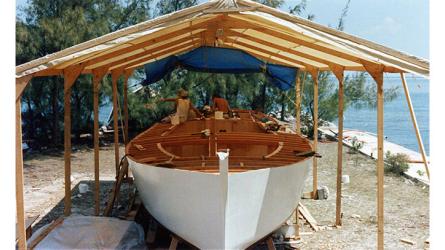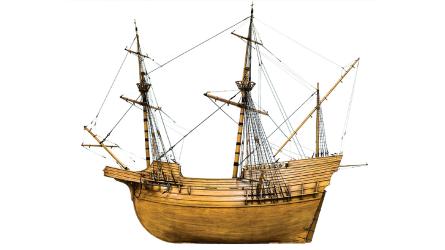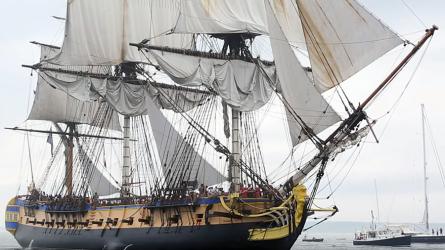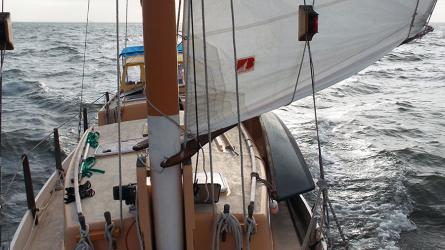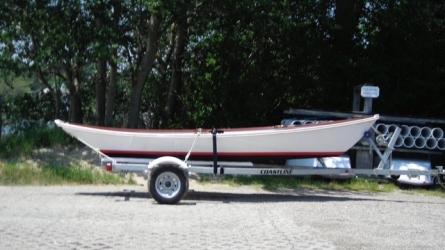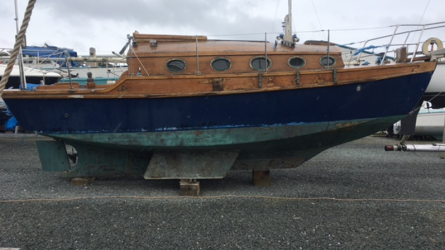The Friendship Sloop BLACKJACK
A faithful, and practical, restoration
A faithful, and practical, restoration
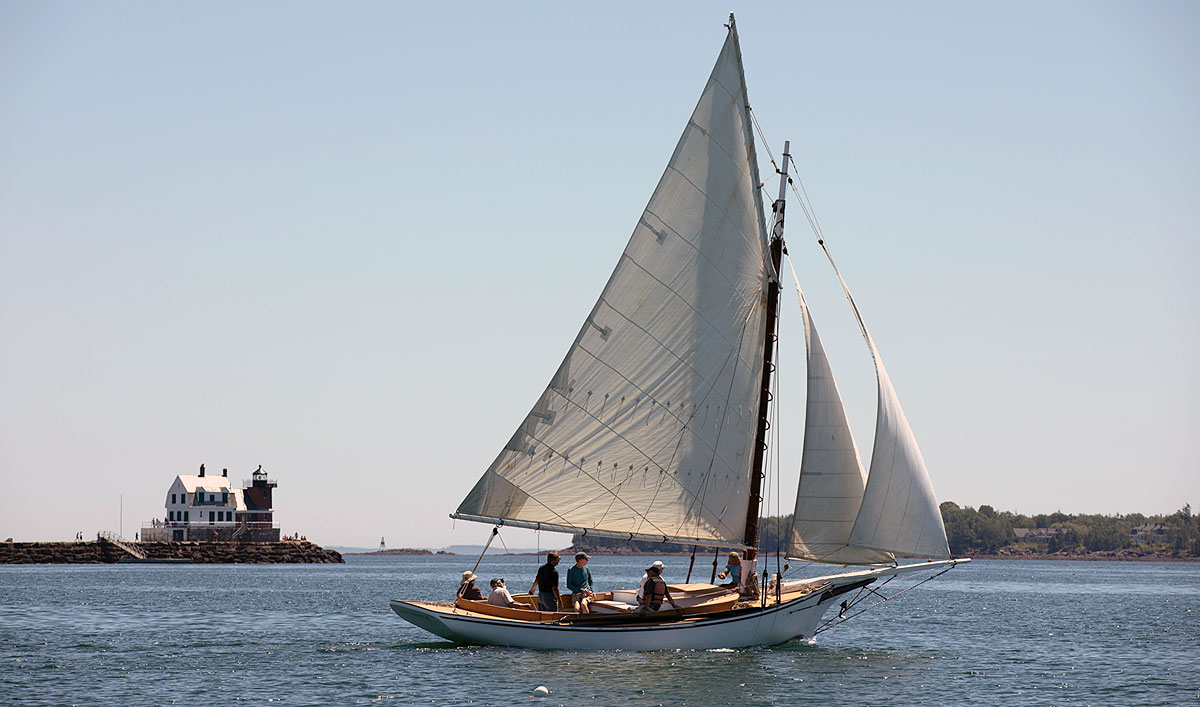
ALISON LANGLEY
BLACKJACK, a 33′ Friendship sloop built in 1900 by Wilbur Morse, sails in her home waters of Rockland, Maine. She was extensively restored by professionals and volunteers at the Sail, Power & Steam Museum, which is her new home.
The Maine sloop-boat, the sailing predecessor to the modern lobsterboat, is an icon of Maine’s maritime heritage. As a professional boatbuilder living and working in Maine who has a particular interest in historic workboats, I had always hoped that I might one day have an opportunity to build or restore one of these so-called Friendship sloops. In the summer of 2016, such an opportunity came my way in the most satisfying way I could imagine: I was asked to restore an original working sloop built by the most notable builder of the type, Wilbur Morse of Friendship, Maine.
Morse greatly influenced the development of Maine sloop-boats, and he was likely their most prolific builder, having launched some 500 of them in a roughly 20-year span starting in about the 1890s. This number does not even include other types of fishing boats and yachts that he went on to build over the course of his career. While most sloop-boat builders of the time preferred to work alone or with just a helper or two, Morse practiced production-style building, employing several workers and streamlining the process as much as possible.
My restoration project, BLACKJACK, is a 31-footer and one of about a dozen Morse boats surviving today. She was built in 1900, and her original name is lost to time, which leaves her history as a fishing boat undocumented. BLACKJACK seems to have been retired from her role as a working boat in the 1920s, around the same time that most of her contemporaries were, and she subsequently became one of the lucky few that caught the eye of an admiring yachtsman.
She underwent a substantial refit for pleasure use sometime in the 1930s, and it was presumably during this time that she was reconfigured with a larger, rather box-like cabin trunk for more headroom and volume belowdecks. Extending the cabin’s length aft decreased her cockpit size dramatically; the interior layout was changed to that of a proper cruising boat; and an inboard engine was added. She would retain this configuration and be used as a private yacht until the 1970s, when she began serving in a daysail charter operation out of Mount Desert Island in downeast Maine.
By the early 2000s, BLACKJACK needed significant structural repair, and she received many sister frames and new bottom planking. Despite these efforts, the years had taken their toll. Her checked and weathered timbers no longer remained firmly fastened, and rot was pervasive throughout.
A well-intended couple from Rhode Island purchased her in 2010, but a few years later they concluded that the project would be too costly for them. Correspondence with the Friendship Sloop Society led them to the Sail, Power & Steam Museum in Rockland, to which the boat was donated. That’s how I ultimately became involved.
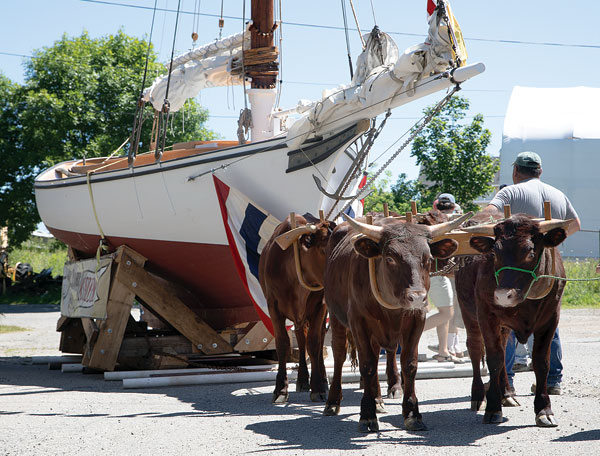
ALISON LANGLEY
Capt. Jim Sharp and the restoration crew envisioned launching the boat as Morse might have done in 1900, and so they arranged for a team of four oxen to haul BLACKJACK to the ramp at the public landing in Rockland, a couple of hundred yards from the workshop where she was restored. Bagpipers and fiddlers are just out of frame.
The Sail, Power & Steam Museum exhibits a wide array of artifacts and information, but its primary focus is on the industrial maritime history of Rockland and the surrounding region, including that of lobster fishing and sloop-boats. As such, the museum had already taken in a few sloops in need of redemption. One of them, a strip-planked and fiberglassed version whose construction was begun in the 1960s and left incomplete until after the builder died, was finished by museum staff and volunteers, and launched as a daysailer for museum visitors and other paying passengers.
When the museum’s founder, Capt. Jim Sharp, received the call about BLACKJACK, he knew the opportunity to acquire and restore an authentic Morse sloop was a rare prospect indeed. They already had a fine representation of the type, but BLACKJACK would be a perfect candidate for a historically accurate restoration. Jim accepted the offer.
Jim Loney, a resident of Friendship who lives less than a mile from where BLACKJACK was built, was hired to lead the restoration. A skilled woodworker with a diverse professional background, he and a crew organized the shop space and solicited donations of tools and timber, landing several thousand board feet of excellent white oak for structural members and white pine for hull planking.
When BLACKJACK arrived, her shape was terribly distorted. Her keel was precariously connected and had somehow cocked over to the port side. While stored in Rhode Island, the heavily ballasted hull was supported by jackstands that were pushing up into her planking. The cabin trunk was collapsing. Before she was transported to Maine, volunteers from the Friendship Sloop Society removed hundreds of pounds of rusty metal ballast and supported the cabin trunk and deck with bracing and posts set on the keel.
With the boat in the shop, Loney and the museum’s volunteers began the tedious process of deconstructing BLACKJACK while the donated timber, delivered as logs, was being milled. When enough of the deteriorated components had been removed, they began replacing her backbone, rudder trunk, and floor timbers. The stem, though dark with patina and embedded with iron fastenings, would remain in place, and by the end of the project it was likely the only original piece left. The existing transom planks and vertical framing would also remain, but they appeared to be only a few decades old.
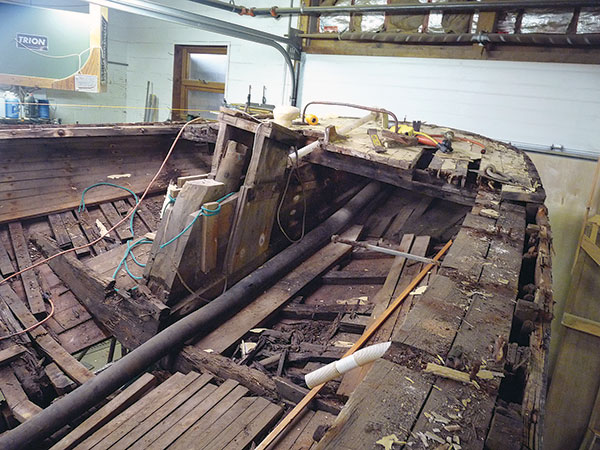
MAYNARD BRAY
BLACKJACK came to the museum in poor condition. Here, with the cockpit mostly disassembled, it is clear that her afterdeck had at one point been partially replanked with 2x4s. The rotten floor timbers are also evident here.
The hull was coaxed to the original shape and held there with bracing and ribbands, then new steam-bent oak frames were installed. Her stern counter had drooped severely over time, and her once-proud sheer had flattened out. As part of the process, maritime historian Maynard Bray, who is technical editor of this magazine and grew up in Rockland within sight of where BLACKJACK was being restored, was called upon to assist Loney with reestablishing the sheerline.
Planking and reframing then began, and along the way, Loney and Bray recorded the hull shape and Bray produced a lines drawing. Using this and a photo of the nearly identical Morse-built GENIE W of 1898, he also drew a profile and deck arrangement.
In May 2016, work had to be suspended due to a lack of funding, and Loney moved on to another project. By the end of that summer, I was hired to complete the restoration. My first order of business was to finish the planking. The donated pine had run out, so we purchased eastern white cedar for the rest of the job. It was a convenient place to begin: the planking routine gave me the time to get to know the boat and do the necessary research for the next stages. I wanted to have a basic understanding of how the original sloop-boats were built, so my first bit of detective work led me to two sources: a Friendship sloop named VOYAGER and a Muscongus Bay sloop named RANGER.
Friendship sloop enthusiasts know VOYAGER. She was the catalyst for the Friendship Sloop Society when, in 1960, her owner, Bernard MacKenzie, felt inspired to organize a sloop regatta in Maine after she performed so well in a race against modern boats. She had been built by Morse’s brother, Charles, in 1906. Charles had once worked in Wilbur’s shop, but eventually opened his own—working with a smaller crew at a slower pace.
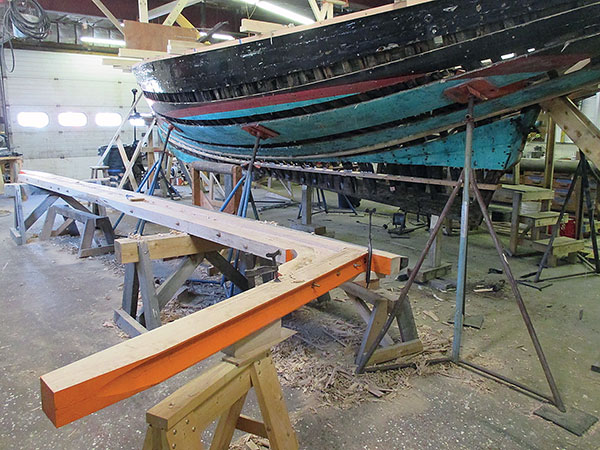
JIM LONEY
With her straight keel and sternpost, BLACKJACK’s backbone required few curved rabbet lines and little compound three-dimensional shaping, so the new pieces were more or less exact copies of the old ones. Shipwright Jim Loney, who led this phase of the project, rebuilt the boat’s structural components as accurately to the originals as possible.
I heard through the grapevine that VOYAGER was still intact and sitting in her present owner’s back yard only a few towns over. With the owner’s permission, I studied the boat and her construction details. Although she was in poor condition, many of her components were original; the only alterations were the typical ones for yacht conversions: changes to her cabin trunk, cockpit, and accommodations. Her structural members and general design were remarkably similar to BLACKJACK’s, so I supposed it safe to assume that Charles had borrowed a good deal of Wilbur’s methods.
Then I went to the Maine Maritime Museum in Bath to examine RANGER, which is cleverly displayed with her starboard side fully restored and her century-old port side left original. She is included in an exhibit on the Maine lobster fisheries alongside a collection of other historic lobsterboats of various types.
The similarities between VOYAGER and BLACKJACK are not surprising, considering they were built only six years apart by two brothers, one having worked in the other’s shop before setting out on his own. But I was not expecting to find such consistency with RANGER, a so-called Muscongus Bay centerboarder built two decades before VOYAGER. Surprisingly, her structural components were exactly the same as the Morse brothers’ boats. While every sloop builder had his particular methods, several features clearly carried over from one yard to the next over time.
Prominent details on most Friendship sloops include the carved trailboards and billethead that adorn their dramatic clipper bows. Neither trailboards nor clipper bows are functionally necessary, but it seems that they were universally present on Morse’s sloops. When the time came to deal with BLACKJACK’s trailboards, I realized that the carvings that had arrived with her were not only too deteriorated to repair but also inconsistent with the photographic and physical evidence of Morse’s work. I would guess that they were made to replace the originals during the 1930s refit. Using old photographs showing a few Morse sloops in profile, I approximated the dimensions and shapes of BLACKJACK’s original gammon knee, trailboards, trail knees, and billethead. I also had a close-up shot from the 1970s of original Morse trailboards, and a private collector loaned me a trailboard made by Charles Morse that had a carved vine almost identical to Wilbur’s. Mike McCune, a talented woodcarver who had helped work on BLACKJACK from time to time, produced the trailboard carvings based on my research while I focused on the billethead.
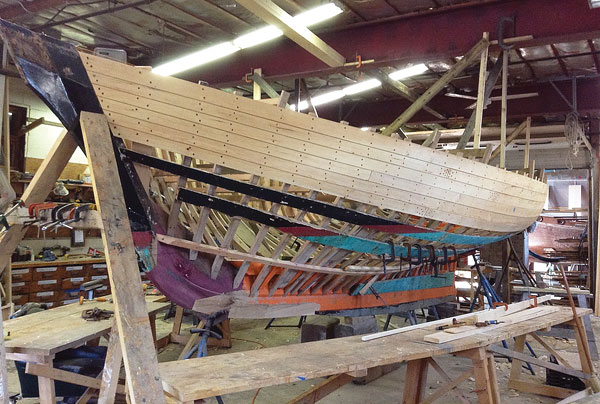
MAYNARD BRAY
The new gripe, visible here at the forefoot of the hull, is made of purpleheart and is the only piece of non-native timber in the boat. None of her planking was salvageable, and no effort was made to replicate her plank lines. Author-builder Tim Clark says, “We lined her off according to what made sense.”
Morse’s signature billethead design was a very rudimentary depiction of an eagle’s head. There are several originals on display at the Friendship Museum, and although their sizes vary, the design does not. As skillfully carved and pleasing to the eye as BLACKJACK’s existing gold-leafed eagle head was, it did not fit with our efforts to re-create the vessel as a historically accurate representation. So, using the originals as prototypes, I carved a new billethead, sized appropriately to the dimensions of the trailboard assembly.
Work progressed steadily and simultaneously elsewhere with several small production-style projects. Wooden cleats, deadeyes, and blocks had to be patterned and produced using various jigs and repetitive multi-step processes. Marshall Merriam, an experienced welder, volunteered to fabricate the new metalwork including chainplates, straps for the new blocks, a new traveler and the modification of a salvaged one, and to clean and repair the spar ironwork.
Morse’s early sloops were mostly steered with a tiller. BLACKJACK arrived with a cast-iron wheel and steering gear that appears in all the existing photos of her, but I surmised that at some time in her life, these had been retrofitted in place of a tiller. We had originally planned to restore the helm’s components, since the particular wheel and gear assembly would have been used on early working sloops, whether installed during a vessel’s construction or added later. Ultimately we decided on tiller steering, and so the crew welded a custom steel rudderstock fitting and cheeks that could be through-bolted to a black locust tiller.
BLACKJACK’s spars were in very good condition, and only a few repairs and modifications were made to them. The mast was replaced during her 1930s restoration, and it is one of the finest pieces of tight-grained Douglas-fir I have ever seen, completely free of any checks or defects. Her original mast would most likely have been shaped from a spruce tree harvested locally, but there was never any reservation about keeping this beautiful and serviceable bit of timber.
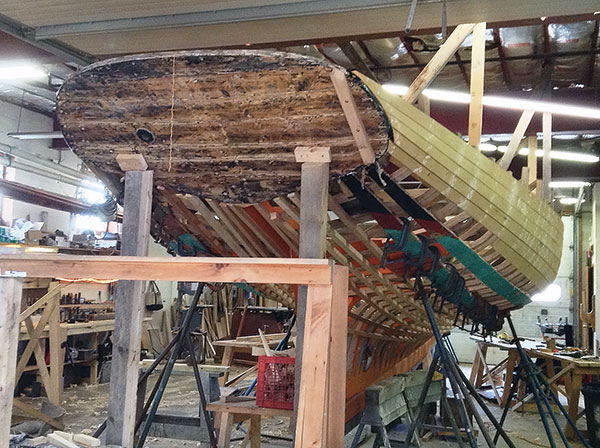
MAYNARD BRAY
Friendship sloop hulls, especially in their after sections, are more complex than many contemporary yacht hulls, and BLACKJACK’s was especially tricky. Though the backbone assembly’s transition from sternpost to horn timber is simply built, the planking was a challenge in this area.
Despite our painstaking effort to build as faithful a Morse sloop as research would allow, practicality had to be considered—both for the boat’s longevity and for the museum’s budget. A common construction detail in Friendship sloops was a series of wide, scarfed-together timbers running fore-and-aft just inboard of the sheerstrakes, under the deck, and on top of the sheer clamps. These so-called lockstrakes served to strengthen the sheer, but only small sections had survived the boat’s various repairs. It was decided to save time and cost by omitting the lockstrakes in favor of more conventional beam shelves atop the sheer clamps. Bray drew up a deckbeam arrangement using this type of construction.
BLACKJACK would also have a fiberglass-sheathed plywood deck rather than the traditional sprung-plank laid deck, for durability and ease of maintenance. The plywood deck would also add rigidity and strength, negating the need for lockstrakes and blocking. Working sloops’ decks were most often painted, so after filling the fiberglass weave and applying a few heavy coats of flat buff paint, BLACKJACK’s deck did not appear glaringly different from an original painted laid deck.
Aside from these fairly inconspicuous departures, the remainder of BLACKJACK’s historical compromises are hidden from view. Silicon-bronze screws and bolts, polyurethane adhesives, epoxy, and other modern materials were used wherever they made sense for strength and longevity. Although these workboats were built to be strong, with beautiful lines and superior performance, they were built of local woods, turned out quickly at low cost, and were not expected to last more than a decade or two. In most cases, surviving original sloops have had many repairs and restorations over the years and have been gradually upgraded with better materials, increasing their resistance to decay.
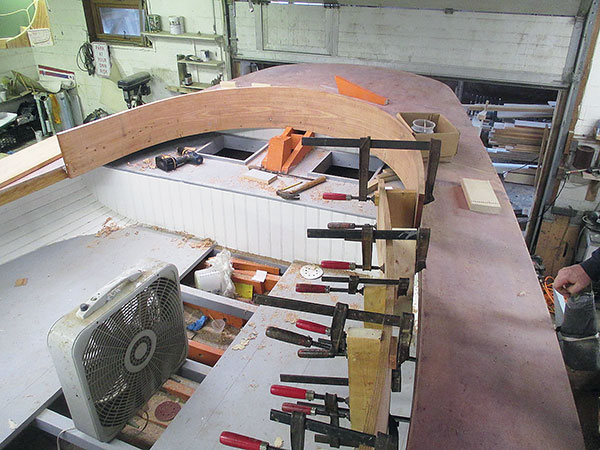
MAYNARD BRAY
The vertical pieces of wood spaced out along the cockpit sides are clamping “cauls” used to keep the coaming from cupping while it is steam-bent into place. Farther aft, the author over-bent the coaming piece so that after springback it would fit to the curve.
In spite of our thorough research, we did not discover any further documentation of Morse’s construction methods; most sloop builders worked directly from carved half models, and they did not document their designs or building practices. They rarely built exactly the same boat twice. Photographs were invaluable for recreating the highly visible elements, but drawings of layout, joinery, components on deck, areas inboard of the coaming, and details inside the cuddy were nearly impossible to find. Many of these mystery details were educated guesses by Bray and me, based on the other sloops we studied or on what made practical sense. Even though built by Robert McLain and not Morse, Mystic Seaport’s 1904 sloop boat ESTELLA A, as depicted on drawings by Robert C. Allyn, served as a guide when all else failed.
When the time came to think about stepping the mast and setting up her new galvanized-steel shrouds, I considered how BLACKJACK’s existing rig was set up and what needed to be changed to represent an early working sloop. We moved some components to more closely match what we saw in the models and drawings we studied, but the setup we came up with is a baseline arrangement that can be adjusted and improved as future use dictates. The long-term hope for BLACKJACK is that she will demonstrate tending wooden lobster traps under sail (see WB No. 161), and the ease of handling through such a maneuver demands convenience and practicality that sailing for pleasure does not.
As BLACKJACK drew close to completion, I was offered another restoration opportunity I could not decline, and unfortunately, the timeline could not wait. Luckily my business partner, Garett Eisele, could take over for me while I continued researching and planning. When I stepped away, I had just finished installing the continuous elliptical steam-bent oak coaming and cabin trunk—a signature element on working Friendship sloops. Eisele completed the cabintop and a host of other details, and readied BLACKJACK for launching.
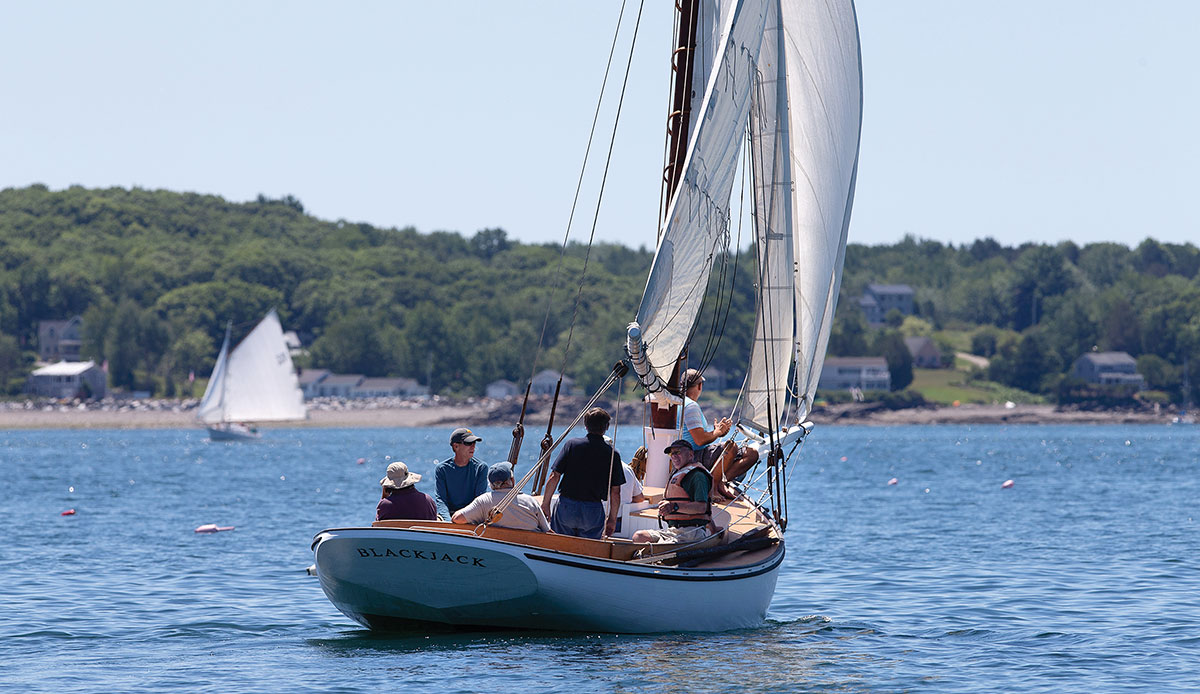
ALISON LANGLEY
BLACKJACK’s sails are the Dacron ones that arrived with her. She will need new sails eventually, and Clark hopes they will be handmade of cotton.
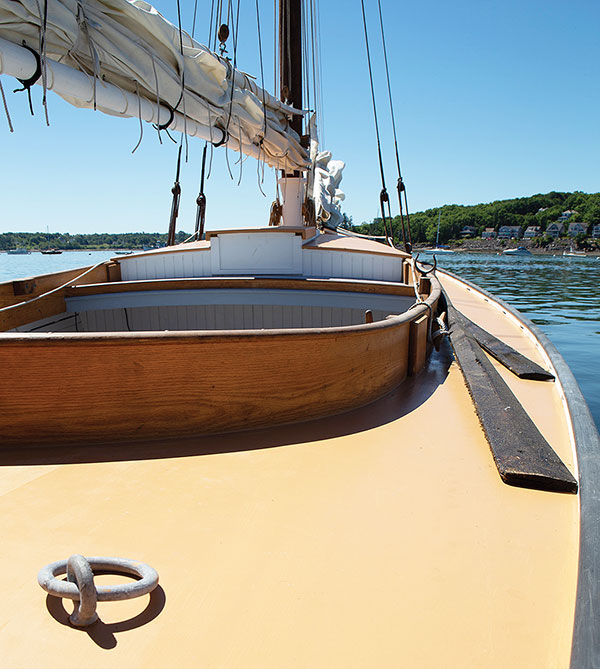
ALISON LANGLEY
The elliptical shape of the continuous cabin trunk and coaming is an aesthetically pleasing design but also a practical one: it makes for a strong assembly with very little structural framing and few joints with the potential to leak over time. Sweeps from an unrelated display at the Sail, Power & Steam Museum will serve as appropriate propulsion for BLACKJACK when the wind fails.
Earlier, Capt. Sharp and I had discussed our vision for BLACKJACK’s launching and decided the proper thing was to do as Wilbur Morse might have done in 1900: We hauled her across the museum grounds with four “blue ribbon” oxen, preceded by a marching band playing fiddles and other instruments. During the fanfare, I wondered how surprised and honored Morse might have been to know that one of his workaday sloops would have survived 100 years to be rebuilt as an educational ambassador of Maine’s technological, industrial, and cultural heritage.
A few weeks after launching BLACKJACK, and following a few sea trials, Eisele and I had an opportunity to sail her. Despite imperfections and much-needed improvements to her sails and rigging, we were astounded by her graceful and predictable performance. I had been admiring her hull shape and thought it one of the finest-looking Friendship sloops I had ever encountered, but now she was proving herself to be just as close to perfection in function as she was in form. She balanced wonderfully, and when pressed by a gust she laid over until the toerail kissed the waves, and there she stayed, finding her equilibrium in just the right place. The wide, surfboard-like run aft maximized her hull’s hydrodynamic potential and provided substantial initial stability.
BLACKJACK was very responsive when tacking—coming through stays quickly and requiring relatively little sea room, as we discovered while sailing past Owls Head Lighthouse, clawing our way against the wind and tide in the narrow Muscle Ridge Channel just around the bend from Rockland Harbor. As BLACKJACK beat into the chop, we were delighted to remain dry as she shed spray from her bow with precision that appeared deliberate. It would seem that after hundreds of sloops built and decades of trial and error, Morse had achieved the apogee of Maine sloop-boat design. With BLACKJACK, we have preserved his legacy in a most tangible and engaging way  .
.
Tim Clark lives in Lincolnville, Maine, and is a partner of Clark & Eisele Traditional Boatbuilding, which specializes in repair and restoration. Previously, he’s worked at shipyards, boatshops, and maritime museums, and has sailed on schooners and square-riggers. He can be reached at www.clarkandeisele.com.
